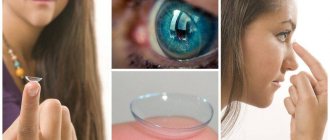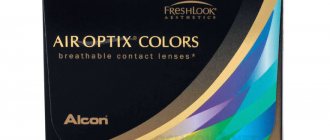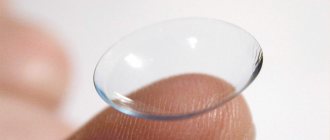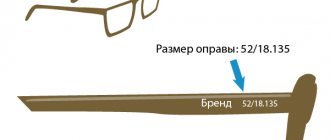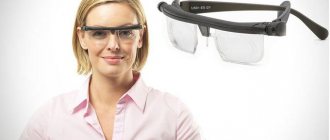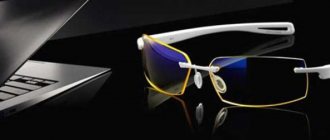Good vision is an important component of the life of any person. Impairments associated with visual refraction often lead to a decrease in quality of life. But today there are effective methods for vision correction. The most versatile and accessible way is to use glasses.
In order for spectacle correction to bring maximum benefit, you need to choose the right glasses. This should be done exclusively by an ophthalmologist. Entrusting the selection of glasses to a consultant in a store means entrusting your health to a non-professional. Ignorant correction is fraught with deterioration of vision, the appearance of headaches, dizziness and the progression of eye diseases. Read on to learn how to choose glasses and what you should pay attention to.
Glasses for myopia
Nearsightedness or myopia is the most common vision problem. About 40% of the world's population suffers from it. With myopia, the image is focused in front of the retina and distant objects appear blurry.
Read about accommodation disorders here.
Most patients suffering from myopia use glasses. This is the simplest, cheapest and safest way to correct this pathology.
Specifics of lenses
Glasses use concave diverging (minus) spectacle lenses that refract light rays in such a way that the focus of the observed object falls directly on the retina. Thanks to this correction, the image in question becomes clear.
If the degree of myopia is small (up to -3 diopters) and the patient does not experience discomfort, glasses for myopia are usually not prescribed. The first degree of myopia does not significantly affect the quality of vision. However, the disease can progress, and this is its main danger.
Types of optical lenses for glasses
The glasses are designed to provide complete correction of myopia, that is, 100% vision. They are used only for viewing distant objects. A person performs work close to the eyes without glasses.
Read about laser treatment for myopia here.
If a patient suffers from moderate myopia (from -3 to -6 diopters), the doctor prescribes glasses for constant wear. In this case, a person sees poorly not only distant objects, but also those located closer to the eyes. He simply cannot do without glasses anymore.
It happens that for work at close distances a second pair of glasses is prescribed or bifocal glasses are prescribed. The upper half of the lenses of such glasses is designed to correct distance vision. The lower half corrects near vision. At the same time, the lower half of the glass is several diopters weaker than the upper.
A high degree of myopia (more than -6 diopters) requires constant wearing of glasses. If the patient requires a significant number of diopters, then he usually experiences intolerance to full correction. In this case, the ophthalmologist prescribes a correction based on tolerance, that is, he provides the patient with not 100% vision, but one with which he will be comfortable.
Children's vision glasses are generally well tolerated. But for adult patients it is much more difficult to get used to them. They are prescribed glasses with weaker lenses, since with full vision correction the eyes will become very tired.
It is difficult for patients who have myopia combined with astigmatism to get used to glasses. You will need glasses with different optical powers.
In general, glasses used for myopia distort the image. Objects in them seem smaller than they are in reality. This is one of the main problems when wearing glasses.
This is how a person with myopia sees
Vertex correction
The difference between the diopters of glasses and contact lenses
Should this vertex distance be taken into account when selecting contact lenses? Is there a difference between the diopters of glasses and contact lenses? What should the diopter ratio be?
In order for the diopters of contact lenses to correspond to the diopters of spectacle lenses, the concept of vertex correction was introduced.
Vertex correction is a mathematical value.
To determine the vertex correction for contact lenses, that is, how much the diopters of contact lenses should differ from the diopters in glasses, there is a special table for converting diopters corrected for vertex distance. Every contact correction room should have such a table. With its help, the optometrist determines how much the diopters of contact lenses need to be changed so that they correspond to the selected spectacle correction, taking into account the vertex distance.
Vertex correction is calculated differently for minus and plus lenses.
As we have already said, minus lenses will become stronger as the vertex distance decreases, that is, as you get closer to the eyes. Therefore, the diopters of minus contact lenses must be smaller to match the selected spectacle correction.
Conversely, lenses with positive values become stronger as the vertex distance decreases (closer to the eyes). Therefore, plus contact lenses must be larger than the corresponding spectacle correction.
Diopter difference value
Another important point that affects the calculation of the vertex correction is the diopter value. How much less or more diopters should be, and what is the permissible difference in diopters, depends on the size of the diopters.
The higher the diopters, the greater the value of the vertex correction, and the more the diopters of glasses and contact lenses do not match and differ. Up to diopter values -/+ 3.75D, the vertex correction value is not taken into account and the diopters in contact lenses correspond to the diopters in glasses.
Farsightedness glasses
Farsightedness is a pathology of eye refraction, characterized by the fact that the image is focused behind the retina.
Glasses for farsightedness are determined by the degree of hyperopia. There are 3 degrees of farsightedness:
- weak;
- average;
- high.
A weak degree requires correction to only +2 diopters. , up to +4 diopters are missing With a high degree of hypermetropia, the eye needs more than four additional diopters.
When choosing glasses, you need to know that a diopter is a unit of measurement of the intensity of light refraction by a lens.
For farsightedness, glasses are needed only for those patients who have the second or third degree. With mild farsightedness, the eye is able to independently correct its function.
People choosing glasses for farsightedness need to remember that this disease comes in several varieties:
- Congenital hypermetropia. In newborns, the refraction of the eye does not normalize on its own. With severe farsightedness, strabismus may occur. Lack of proper treatment leads to a significant decrease in vision in one eye (amblyopia).
- Physiological hypermetropia. Typical for children of primary school age.
Treatment of hypermetropia is described in the material.
To select glasses for patients with hypermetropia, it is necessary to determine its degree. This can only be done in a doctor's office.
Selection process
How to choose glasses for vision. The patient sits on a chair and looks at a board with letter symbols located 6 meters away from him. The board should be well lit. In the first line there are large letters, and then, as the lines go down, their size decreases. The left and right eyes are examined in turn. During the vision test, one eye remains open and the other is covered with a special shield. The doctor shows the letters starting from the top line. Visual acuity will be indicated by the line in which the patient named all the letters correctly. You can also select glasses lenses online and take a color blindness test.
Effect of spherical and aspherical lenses
The next stage is the selection of spectacle lenses. To do this, the patient is given a set of biconvex lenses. If he sees well through them, then a conclusion is made about the presence of farsightedness and the doctor provides lenses. Each subsequent lens refracts the rays more strongly. The selection ends when the patient begins to see objects poorly.
When the degree of farsightedness is determined, the question of what glasses the patient needs is decided: plus or minus. If you are farsighted, you need to purchase glasses with positive diopters.
When purchasing glasses at an optical shop, you need to pay attention not only to the frames of the glasses, but also to their strength. For farsightedness, it is important that the refractive power is optimal. If the patient has first degree farsightedness, then glasses will not be needed. If hypermetropia is 3.5 diopters, then glasses are taken 1 unit less than the degree detected during the visual acuity test.
If glasses are selected for children, then at the age of 6-7 years (in the absence of strabismus and amblyopia) they can be canceled.
It should be remembered that if you have headaches or decreased visual acuity, glasses are necessary even in cases of mild farsightedness. It is noteworthy that with age-related hypermetropia, the distance from the organ of vision to the object in question is also taken into account. This is very important for those patients whose professional activities involve heavy visual load.
Spectacle glasses and frames
Glasses for myopia correction have a number of features: they are thinner in the center and thicken closer to the edges.
The traditional material for making spectacle lenses is mineral glass. However, such glasses have a significant drawback: they are quite heavy.
Astigmatic lenses and the marking principle are located at the link.
Today, most eyeglass lenses are made from different types of plastic. They are relatively light, durable, and scratch resistant. There are different types of plastic lenses:
- polycarbonate;
- high-index;
- aspherical;
- photochromic, etc.
Polycarbonate lenses have a high refractive index. They are suitable for children involved in sports.
three types of glasses
- metal;
- plastic;
- glasses without frames for vision.
The choice of frame type depends on the degree of development of the pathology. In the prescription for glasses, the doctor indicates the number of diopters that determine the magnitude of this pathology.
Plastic frames are wider, suitable for severe degrees of nearsightedness (myopia) or farsightedness. In case of myopia, such a frame covers the thick edges of the lenses and tightly compresses them around the perimeter.
Metal frames are more acceptable for mild to moderate degrees of pathology.
Rimless glasses can only be used for mild myopia. The edges of the lenses in this case are thinner, but they will be more noticeable than in a metal or plastic frame. These glasses do not use lenses made of mineral glass, since this material has a high specific gravity.
Infiniti 1 lens, positive diopters
Infiniti contact lenses are ideal for correcting vision defects such as myopia and hypermetropia, including high values. Products from the Korean company OKVision boast excellent optical properties, and their quality has been repeatedly recognized by experts, as evidenced by numerous international certificates.
These lenses are made of non-ionic Terpolymer material, thanks to which contact optics have such properties as resistance to various types of contamination and strength. In addition, the lenses are resistant to mechanical damage.
Lath Cut Technology
The lenses are easy to use and even a beginner can easily put them on and take them off. Infiniti ophthalmic products are manufactured using high-precision equipment using double-sided turning (this technology is called Lath Cut). This approach makes it possible to produce products with excellent optical characteristics. Thanks to the special design, thin edges and small thickness of the product in the central zone, optimal circulation of tear fluid is achieved and the sliding of lenses along the cornea is facilitated.
A UV filter built into the structure protects the eyes from bright light. It is known that harmful exposure to sunlight most often leads to the development of photokeratitis and cataracts. That is why on the street, especially in summer in clear weather, it is worth using sunglasses along with contact optics.
Six months is how long you can wear Infiniti contact lenses. Once every six months - this is the frequency with which you need to change these ophthalmic products. Agree, this is quite convenient and profitable. At the same time, optical products have a small thickness, so they are comfortable to use throughout the entire period. The lenses are designed for daytime wear, so your eyes can fully rest at night.
As mentioned earlier, OKVision Infiniti lenses are suitable for patients with farsightedness (the range of optical parameters varies from +1 to +20) and myopia (from -0.50 to -20). The manufacturer offers a choice of two radii of curvature - 8.40 and 8.70.
Infiniti lens care
OKVision GOLD disinfection solution is perfect for this model. In this case, you can also use other liquids intended for the care of hydrogel lenses. But for those who suffer from increased eye sensitivity, ophthalmologists advise using peroxide cleaning systems.
In the Ochkov.Net online store you can purchase Infiniti, 1 lens in a bottle, at a bargain price. For the convenience of customers, delivery throughout Russia is available.
Symptoms of incorrect selection of glasses for vision
A blurry, unclear image is the main sign that the glasses are chosen incorrectly. The patient may not feel discomfort if the difference between the selected lenses and the required ones is insignificant. However, a large difference in diopters can cause eye strain and, as a result, headaches, dizziness, and nausea.
Sometimes these phenomena can occur during the period of getting used to new glasses. This effect may cause some spatial disorientation, but will disappear after a while.
If after 7-10 days the headaches and blurred vision do not stop, it is necessary to determine their cause . To do this, it is better to contact the ophthalmologist who wrote the prescription. If the doctor confirms that the parameters of the required lenses are determined correctly, you need to contact the optical shop that manufactured the glasses. It may be necessary to adjust the position of the lenses in the frame.
Lens diagram
Incorrectly chosen glasses can cause constant eye fatigue. If you wear them for a long time, the pathology will progress.
Contact lens selection procedure
The contact lens fitting procedure involves measuring the curvature of the cornea using a special instrument (keratometer).
The curvature of the cornea can also be measured using automatic devices (refkeratometers). The data obtained in this way will be the starting point for the doctor to determine the basic geometric parameters of contact lenses (base curvature and size) that are most suitable for you. If these parameters are not taken into account when selecting contact lenses, then the selected lenses may have either a too “flat” or too “steep” fit on the eye. In these cases, you will experience discomfort when wearing contact lenses, and such lenses may even cause harm to your eyes (damage the cornea). Often, when selecting contact lenses, the condition of the tear film of the eye is assessed (in other words, they check whether the cornea of the eye is sufficiently hydrated). If your eyes are too dry, wearing contact lenses may not be the best way to correct your vision and you may be better off wearing glasses. If you have certain problems with dry eyes, but they do not bother you too much, your doctor will recommend contact lenses that best solve these problems. In these cases, you can try, for example, lenses with a wetting agent. Additionally, you can use moisturizing and/or lubricating drops offered by a number of companies to relieve symptoms of dry eyes when wearing contact lenses. Please also keep in mind that prolonged wearing of contact lenses (several days in a row, without removing them at night) should not be used for symptoms of dryness.
In addition to assessing the condition of the tear film, the doctor must also conduct a thorough examination of your eyes using a slit lamp (so-called ocular biomicroscopy). This is done to check that your eyes are not damaged and that there are no other problems that may prevent you from wearing contact lenses comfortably. This examination will also provide the doctor with initial information to assess the extent to which your eye condition has changed during subsequent examinations that you will need to attend in the future if you continue to wear contact lenses.
Next, the doctor may suggest that you try on so-called trial lenses with parameters suitable for you in order to evaluate the fit of the lenses on the eye and their mobility using a slit lamp. This stage is included in the standard procedure for selecting lenses and during subsequent visits to the doctor. There are cases when lenses fit well immediately after fitting, but after a few hours their fit changes greatly.
Your doctor should also tell you how long you should wear your lenses and how to care for them.
Once your doctor is satisfied that the lenses fit well, provide good quality of vision and comfort, and that they do not have any harmful effects on your eyes, you will be prescribed contact lenses. The lens prescription must indicate the power of both lenses, the base curvature and the diameter of the lenses.
Tips for choosing
For anyone who is planning to purchase glasses, we offer a number of simple but very useful tips that will help avoid many unpleasant situations:
- Before purchasing glasses, you must be examined by an ophthalmologist.
- If, as a result of a visit to the ophthalmologist, it turns out that you need low-refraction lenses, then you can safely buy any frames made of plastic, metal, with or without a rim. The small thickness of such glass allows this to be done.
- When choosing frames, comfort comes first. Elegance and fashionability take a back seat. Inconvenient frames can not only ruin your mood, but also impair your vision.
- You should not choose very large and round glasses for vision: they will require heavier lenses, which, in turn, leads to rapid fatigue from glasses. If you decide to buy a large frame, then be sure to try to choose a model with wide nose pads. This will increase wearing comfort.
- Plastic frames hide high-refraction lenses better.
- For bifocal and progressive lenses, you should not choose an excessively narrow frame: it will not allow you to place the lens with a sufficient area responsible for myopia.
- Photochromic lenses are not suitable for drivers because they can only darken in direct sunlight. It is better to purchase regular tinted lenses or special anti-glare glasses for drivers.
- Any new glasses with a changed number of diopters will take some time to get used to.
Why does age-related farsightedness occur and what methods of vision restoration exist?
Read this article to learn how to restore your vision.
Dacryocystitis in adults: https://eyesdocs.ru/zabolevaniya/dakriocystit/u-vzroslyx-lechenie.html

